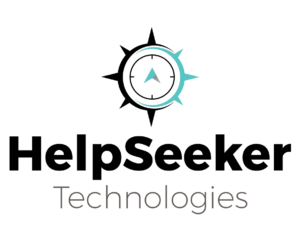Across Canada, communities constantly face social challenges due to a siloed and uncoordinated response to social issues that include mental health, addiction, homelessness, domestic violence, sexual harassment, and poverty. These issues have negative impacts on individuals and communities, particularly during the current COVID-19 pandemic.
While COVID-19 has undoubtedly increased financial, health and wellbeing pressures for individuals and families, it has also served to expose fault lines in the social safety net — including discrimination and inequitable treatment — that existed prior to the pandemic.
But to fully understand the scope of change needed, a thorough understanding of the social safety net and its challenges is required. This also includes understanding financial information — where money is coming from and going to.
Social Impact Audits Explained

As a social technology B-Corp, our team at HelpSeeker Technologies develops digital solutions to support the transformation needed for a more equitable social safety net. One of the key pieces we’ve been pushing forward is the Social Impact Audit (SIA)— an analysis of diverse funding sources coming into a local social safety net. This serves as a key building block for understanding the change needed for a transparent and coordinated system that champions equitable wellbeing.
Why is this level of funding transparency and coordination important?
The proliferation of funding streams and agreements to tens of thousands of programs and organizations has meant that our social safety net has become extremely convoluted and difficult to understand. This is further complicated by the levels of government-delivered services internalized by various departments (not contracted out).
The SIA is a key first step in any cross-sector/jurisdictional assessment of service effectiveness and efficiency because it provides the government with an analysis of all current investments and resources locally available against community needs and best practices. It aims to help communities to analyze financial flows locally, identify service gaps, guide the implementation of innovative models of service delivery, and promote the coordination of resources available to individuals.
To date, we’ve had the tremendous opportunity of working on 15 different Social Impact Audits in Alberta, B.C., Ontario, and New Brunswick with more underway. Here, we reflect on why we think this information matters, particularly for funders, social policy makers, service providers, and researchers.
5 Takeaways for Policy Makers and Funders
Here are the takeaways from our first 15 Social Impact Audits:
1. There is limited understanding of the full breadth of social services.
It’s no surprise that the social safety net is fragmented — we hear this all too often from those with lived and living experience. But what’s surprised us is just how fragmented funding flows are. In turn, this makes the ‘system’ not much of a system at all — but rather, a patchwork of services bundled into programs with varying and constantly changing criteria.
Our systems mapping efforts have documented over 250,000 service elements — and we haven’t even started Quebec or the East Coast in earnest. When we consider that this includes charities, non-profits (which are legally different from charities), publicly delivered services, informal voluntary groups, private foundations, and the private sector, it’s clear just how complex the ‘system’ is.
Funders often rely on a partial understanding of service gaps when they make decisions about investments, and in so doing, sometimes miss the bigger picture of what’s actually going on locally. But, with a clear understanding of the local social services, they can then connect the dots to funding and ask more questions. This is where we can identify what’s effective and needs to be scaled, vs. what should be retooled or recalibrated.
2. Funding transparency is lacking in the social safety net.
The springboard to our SIA efforts has been the Open Data and Open Government movements taking root in recent years. Without data available and analyzed, it’s impossible to trace funding to and from the hundreds of thousands of moving pieces in the social safety net.
For instance, we’ve sought to understand what’s happening with Edmonton’s social safety ecosystem through our work with the Edmonton Police Service. We found $7.5 billion annually going into community social services charities, and public health for mental health and addictions programming, first responders (EPS, EMS, Fire) and direct government transfers to individuals. About $2.1B per year was going to community and social service charities — but much of the data was missing, especially data from any social service nonprofits that were not charities, or contracted private social services or government agencies delivering social services directly. Ideally, this would all be available as Open Data to allow for a fulsome analysis.
3. The public expects more transparency from the government for social spending.
Even before COVID, the public’s expectations of the social safety net were shifting. Public awareness is important, and people want to be able to easily find and navigate information, especially when it’s about the support they can benefit from or are invested in. We often hear government sentiment about the need to ‘cut Red Tape’ or reduce public confusion. We also hear calls to increase transparency over how funding decisions are made or the ethics of procurement.
As more communities embark on Social Impact Audits, the mainstream media is paying more attention to these issues and probing further, especially in light of the large funding numbers involved.
We are often asked where money should be spent, or where duplication exists to enable systems to transform and become more effective. Of course, we always have to point out that this is the first time this level of analysis has been done, and there is so much data still missing. This is why we published our recent Edmonton SIA online. It’s a step in the right direction, but as a sector, we still have a long way to go.
4. Funding coordination is a collective responsibility.
The insights of Social Impact Audits point to a lack of coordination, alignment, and integration when it comes to funding. At a minimum, we should be able to understand which departments are funding which services, their activities, and their measurable outcomes. This should, in turn, be consistent across ministries and governments and philanthropy.
We suggest enhanced funding coordination can enable all stakeholders (service providers, policy makers, researchers and service users) to better understand how our social safety net actually works. Following the money will not tell us everything, but it will tell us a lot. Already, the limited available data we were able to analyze tells us how essential these services and organizations are to our economy and the ability to meet essential social needs.
A coordinated government Social Funding Framework would support this tremendously. Canada could leverage its current Open Government initiatives to support this effort, and do so as close to real-time as possible.
5. The future of Social Impact Audits is digital.
This is an important reflection point for us and the communities we are working with. Because we are finally in the position to automate a relatively onerous and manual process of cleaning and analyzing data, we can shift from producing thousands of online dashboards using the data pipelines and cleaned datasets we’ve been building for our Community Success Hub.
Rather than a one-off report, the Social Impact Audit is one of the key modules in this decision support platform, taking in hundreds of data points pertinent to the social sector, including financial information, to generate trends, comparisons, in-depth analysis and insights. This module is available at your fingertips, at a fraction of the cost and time of traditional needs assessments. In addition to trends, the platform also generates suggestions and solutions to shorten the time from research to action. En masse, this information will be a significant leap towards enabling data-driven decision-making.
Where Do We Begin?

At a minimum, it would be tremendously beneficial for all funders to collect and publish a breakdown of very basic information as illustrated below.
The example of the fictional Kids-R-Great Program:
| Program Name | Kids-R-Great-Program |
| Organization Name | Awesome Kids Charity |
| Services Provided | Recreation; early childhood education; parenting supports |
| Target Populations | Children with mental health challenges |
| Eligibility Criteria | Must be 18 years or younger |
| Service Catchment Area | Saskatoon |
| Total Funding (2021) | $1.5M |
| Funding Sources | $200k | $500k | $700k | $50k | $25k |
| Government | Government of Canada | Government of Saskatchewan | City of Saskatoon | Government of Canada | Government of Canada |
| Ministry | Health | Social Services | n/a | Justice | Employment & Social Development Canada |
| Department | Public Health & Prevention | Vulnerable Children’s Unit | Community & Neighbourhoods | Crime Prevention | Reaching Home |
| Funding Stream / Program | Early Childhood | Healthy Children Initiative | Healthy Children | Early Intervention | Homelessness Prevention |
| Eligibility Criteria for Clients | Must be 18 and under Priority for Indigenous children |
Children 12-16 Experiences of Trauma |
Children with mental health challenges- doctor note | Children with justice involvement | Children at risk of homelessness/homeless (in shelter / couch surfing) |
| Target Outcomes | Prevent chronic diseases in adulthood by enhancing healthy behaviours | Enhanced coping skills for child & family Reduced trauma |
Enhance mental health outcomes | Decrease crime involvement | Reduce homelessness Prevent future homelessness Reduce public system use |
This is a simple, yet powerful, step to creating consistency and a better understanding of the services and benefits delivered in our social safety net. We also encourage major donors and philanthropists to do the same for their contributions. From here, we can begin to unravel the web, and for the first time in our history, begin truly understanding the complexity of the social safety net.
As for HelpSeeker, we will continue to drive for more transparency and shed light through our Community Success Hub’s Social Impact Audit. As more data sets become available, we will continue to support the communities we work in and drive social impact further.
Looking to learn more? Visit HelpSeeker.co.


